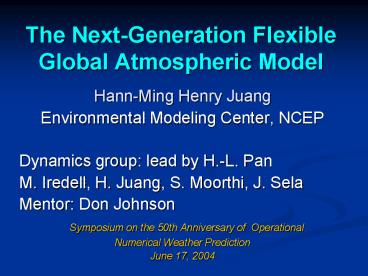The NextGeneration Flexible Global Atmospheric Model PowerPoint PPT Presentation
1 / 31
Title: The NextGeneration Flexible Global Atmospheric Model
1
The Next-Generation Flexible Global Atmospheric
Model
- Hann-Ming Henry Juang
- Environmental Modeling Center, NCEP
- Dynamics group lead by H.-L. Pan
- M. Iredell, H. Juang, S. Moorthi, J. Sela
- Mentor Don Johnson
- Symposium on the 50th Anniversary of
Operational - Numerical Weather Prediction
- June 17, 2004
2
Introduction
- Reasons to develop new code
- Flexible to test different dynamical cores
- Develop to work with others, e.g. ESMF
- Contents
- Current design for flexibility
- Current accomplishment
- Immediate next steps
- Future concerns
3
Rules of Code Design
- Fortran 90 modules, libraries built.
- C preprocessor for compiling options
- NAMELIST for running-time dimension
- Data structure for generalization
- Pluggable physics packages
- Possibly pluggable dynamics
- ESMF-type for super-structure
- Easy to maintain and friendly to use
4
Concept of Code Structure
Super structure
APIs
Model layers
APIs
APIs official ESMF local ESMF WRF API etc.
5
Element of Super Structure
preprocessing
package
execution
postprocessing
6
initial_prep
(read namelist, allocation)
initial_input
(read input and data etc)
atmos_initial
initial_post
(constant initialized)
model_prep
(allocate temporary spaces)
atmos
atmos_model
model_integrate
Model_post
(deallocate temporary spaces)
(prepare data for output)
final_prep
(write output or restart data)
atmos_final
final_output
final_post
(deallocation)
7
integrate_init
( prepare coefficients )
integrate_radiationpre
(integrate_getgrid)
integrate_radiation
integrate_dynamicpre
(integrate_getgrid)
integrate_dynamics
model_integrate -
(integrate_getwave)
integrate_dynamicsadj
integrate_physicspre
(integrate_getgrid)
integrate_physics
(integrate_getwave)
integrate_physicsadj
integrate_fine
( updating, time-filter etc)
8
dynamics_hybrid
( compute all values related to vertical
coordinates etc )
integrate_dynamics -
dynamics_nonadv
( compute all forcing except 3d advection )
dynamics_advect
( Eulerian or Lagrangian )
9
atmos_initial
atmos2ocean_initial
ocean_initial
ocean2atmos_initial
atmos_model
atmos2ocean_trans
atmos_ocean -
ocean_model
ocean2atmos_trans
ocean2atmos_final
ocean_final
atmos2ocean_final
atmos_final
10
Data Connection
Variable structured data
Structured Data
Definition structured data
Pass structured data, not by common block.
11
Generalized Variable Structure
- type atmos_dynamics_vars_type
- realDYN_KIND, pointer
valu(,,) - character5 , pointer name()
- integer , pointer
indx() - integer len,lev, stp, num
- endtype atmos_dynamics_vars_type
12
Variable Definition
- type atmos_dynamics_defs_type
- character datatype4
- integer , pointer date()
- real fhour
- real , pointer dx()
- real , pointer dy()
- real , pointer ds()
- real , pointer sl()
- real , pointer si()
- integer numx,numy,nums
- integer numtracer,numdate,numwave
- endtype atmos_dynamics_defs_type
13
Running-time Dimension
- Pass dimension and options through NAMELIST as
- ATMOS_DEFINE
- datatypecoef',
- wavenumber64, layernumber28,
- longitudenumber108, latitudenumber1,
- initialtime0.,
finaltime240., - timestep1800., filter0.92,
- END
14
Current Accomplishment
- Implement all designs
- Implement current operational dynamics and
physics - Testing in three different platforms ibm-sp,
origin-o2k, pc-linux - Stable up to monthly integrations
- Single and multiple tasks
15
Model Grid
- Spectral model with spherical transform is
suitable for spherical domain. - Reduce Gaussian grid (Williamson and Rosinski,
2000) - Reduce spherical transform (Juang 2004)
- Reduce Gaussian grid
- Reduce Legendre computation
16
(No Transcript)
17
Reduced (color)
Full (black)
Reduced - Full
18
Hybrid Parallel Computing
- Code structure is the same for single and multi
PE s - Only IO and spectral transform routine contain
MPI related calls - 2D decomposition with 1D option
- 2D can run more PE s
- 1D is faster in vector machine
- Multi-threads for outmost do-loop
- Consider vector in inner do-loop
- For different of PEs without recompiling
19
(No Transcript)
20
(No Transcript)
21
24-h accumulated rainfall from FGM
Contour intervals of 4x10-4 m
22
Next Steps
- Generalized vertical coordinates
- Implemented a generalized coordinates
- Emphasized on sigma-theta coordinates
- Current variables U, V, T, P, and tracers
- Comparisons forecast skills
- Differences between sigma-p to sigma-theta
- Differences from the operational one
23
Hydrostatic system in generalized vertical
coordinates
24
P0
z0
q-gtinfinite
Isentropic dz/dt0
PP(q)
zqs/q
PPq0
qq0
PA(z)Pq0B(z)Ps
sigma
PPs
z1
25
Future Concerns
- Improve Dynamics as well as Physics
- Un-approximated primitive equation
- Higher resolution physics
- Improve Numerical Methods
- Optimal between conservation and accuracy
- Adopt multi-dynamical cores
- Linkage to other components of earth models
through ESMF
26
Model Equation
- Nearly all global models are
- Hydrostatic system
- Diagnosis vertical momentum
- Shallow-atmosphere assumption
- Next generation could be years later
- Very high resolution is expected
- Hydrostatic is not valid
- Full Coriolis effect
- Deep atmosphere
27
Momentum Equation
28
Un-approximated Approach
- From energy point of view
- Energy1/2u(du/dt)v(dv/dt)w(dw/dt)
- Coriolis force and curvature terms are cancelled
out - Cosine component of Coriolis force contributes to
zonal vertical circulation - And raz provides accurate curvature and
displacement - Generalized vertical coordinates (Staniforth and
Wood, 2003)
29
Full Coriolis Effect
- Sine component of it modifies the flow pattern at
middle- and high-latitudes - Cosine component of it modifies the vertical flow
patterns at tropic and extra-tropic areas. - Coriolis force is approached to 10-4 from f and
10 from u, so it is about 10-3, and w is 10-2,
10 effect in w.
30
Not-shallow atmosphere
- For shallow assumption
- r a (earth radius)
- For non-assumption
- r a z
- Not only affect gradients, curvature terms but
also displacement by wind, - since u r cos? d?/dt and v r d?/dt
- For example, 50 m/s wind from100 hPa (20km) to
0.2 hPa (60km), errors in ra are from 0.2 to
above 1, thus, errors in displacement after 10
days are from 20 km to 432 km.
31
Final Note
- With the combinations of
- Sigma-theta coordinates to reduce the errors in
vertical advection - Deep atmosphere to reduce the errors in
stratospheric horizontal advection - Full Coriolis effect to have better vertical
circulation along tropical areas - The improvement on dynamical weather and climate
forecasts can be expected.

